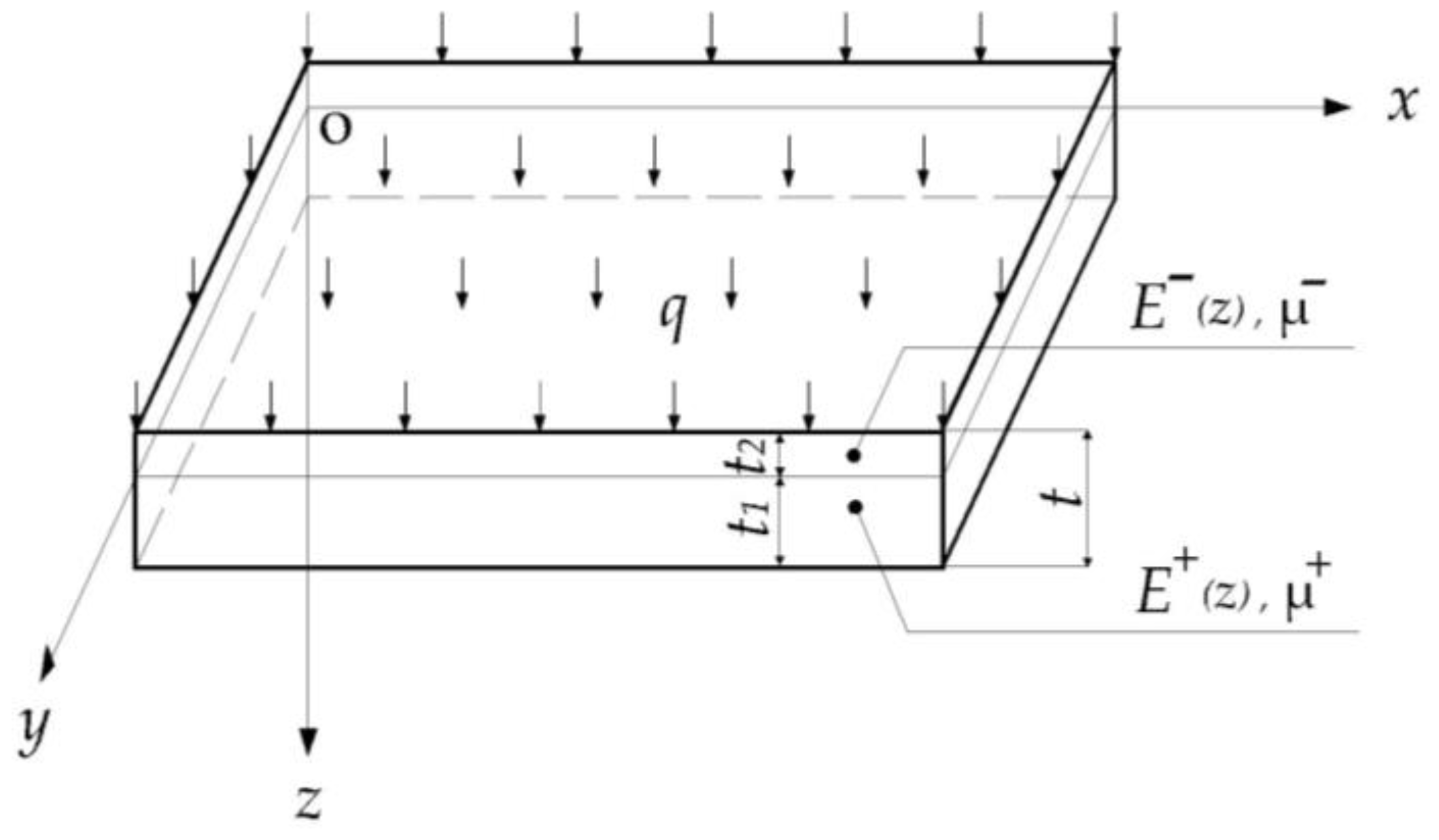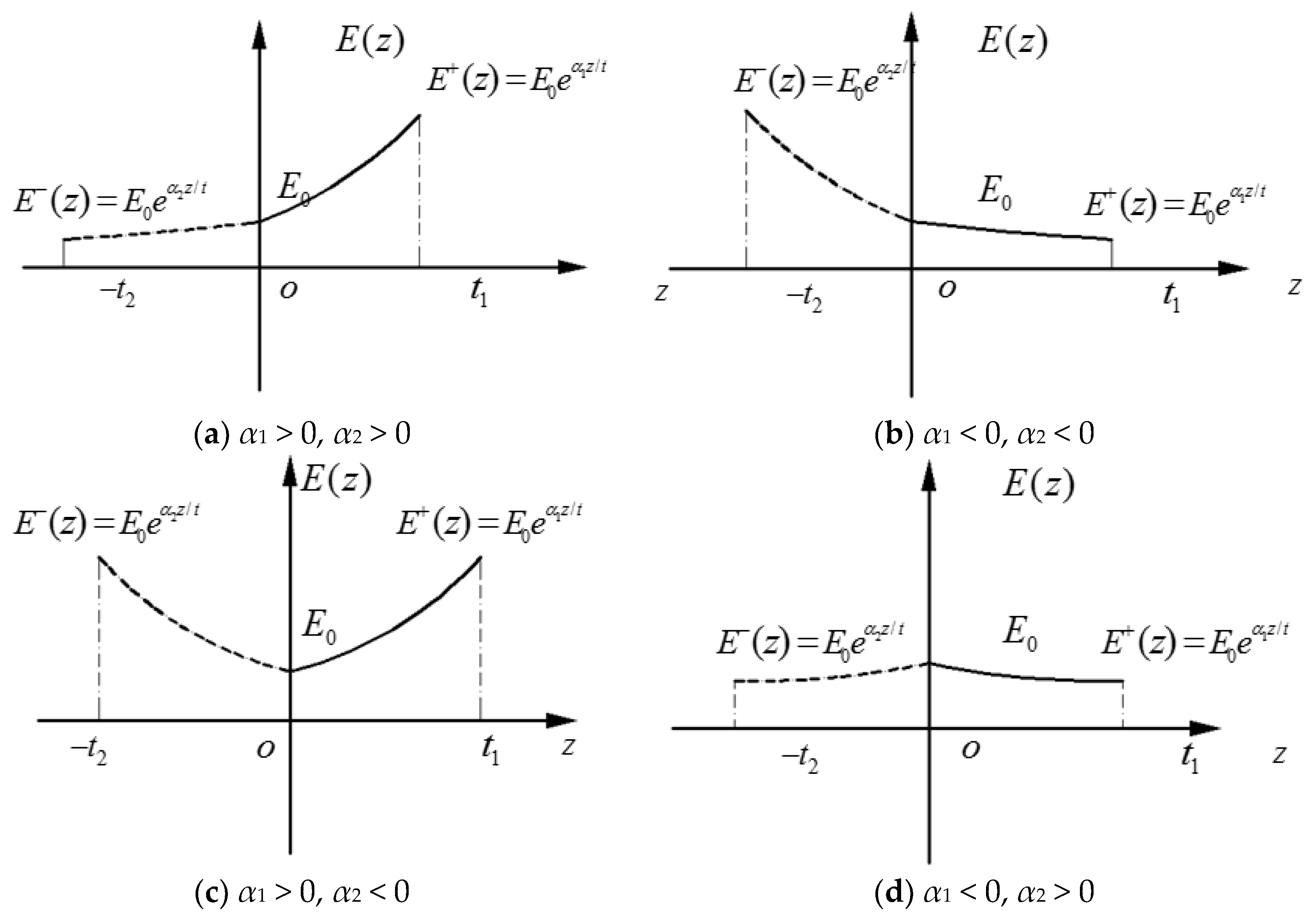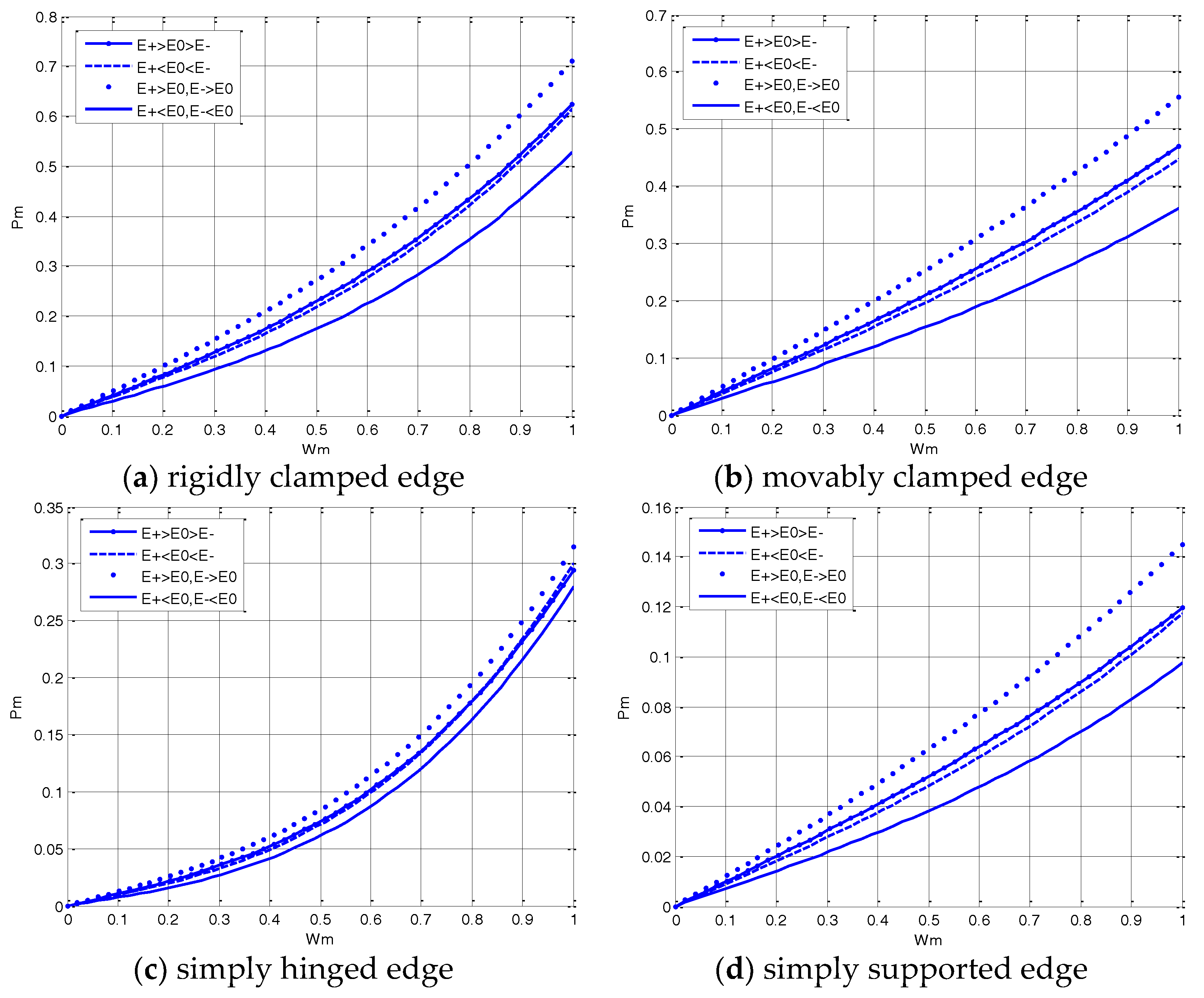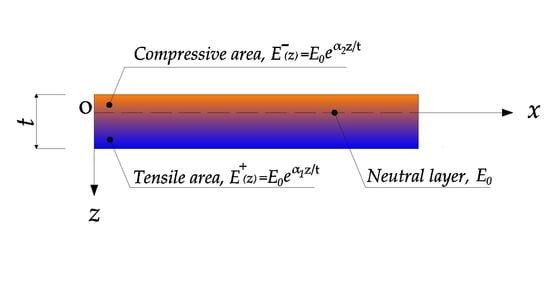Non-Linear Bending of Functionally Graded Thin Plates with Different Moduli in Tension and Compression and Its General Perturbation Solution
Abstract
:1. Introduction
2. Föppl–von Kármán Equations of Bimodular FGM Thin Plates
2.1. Equation of Equilibrium
2.2. Consistency Equation
2.3. Axisymmetric Case
3. Application of Perturbation Method
3.1. Nondimensionalization
3.2. Perturbation Solution on
3.3. Perturbation Solution on
4. Results and Discussions
4.1. Comparisons between Two Solutions
4.1.1. Load vs Central Deflection
4.1.2. Deflection and Radial stress
4.2. Bimodular Effects of FGMs on Deformation
5. Concluding Remarks
- (1)
- The mechanical model based on the neutral surface enables us to easily establish the governing equations, especially for the consistency equation. The tensile effect in bimodular FGM thin plates is fully taken into account, as indicated in Equation (18), the coefficients , and are integrated along the whole thickness, only for the tensile functions.
- (2)
- During the perturbation, the central deflection and the load are selected as perturbation parameters, respectively. The results indicate that the two selections for perturbation parameters are equivalent and the two solutions are convenient for engineering application.
- (3)
- The introduction of bimodular grade parameters, and , enables us to distinguish, effectively, the relative magnitude among , , and , thereby obtaining some meaningful results of bimodular effect on stiffness and deformation. The dominant factor influencing the stiffness magnitude is still the modulus of elasticity. Especially, if the modulus of the neutral layer is used as a reference value, the capacities resisting deformation are in turn, from strong to weak, , , and .
Author Contributions
Acknowledgments
Conflicts of Interest
References
- Cheng, Z.Q.; Batra, R.C. Three-dimensional thermoelastic deformations of a functionally graded elliptic plate. Composites B 2000, 31, 97–106. [Google Scholar] [CrossRef]
- Reddy, J.N.; Cheng, Z.Q. Three-dimensional thermo-mechanical deformations of functionally graded rectangular plates. Eur. J. Mech. A/Solids 2001, 20, 841–855. [Google Scholar] [CrossRef]
- Ma, L.S.; Wang, T.J. Relationships between axisymmetric bending and buckling solutions of FGM circular plates based on third-order plate theory and classical plate theory. Int. J. Solids Struct. 2004, 41, 85–101. [Google Scholar] [CrossRef]
- Chi, S.H.; Chung, Y.L. Mechanical behavior of functionally graded material plates under transverse load—Part I: Analysis. Int. J. Solids Struct. 2006, 43, 3657–3674. [Google Scholar] [CrossRef]
- Li, X.Y.; Ding, H.J.; Chen, W.Q. Elasticity solutions for a transversely isotropic functionally graded circular plate subject to an axisymmetric transverse load qrk. Int. J. Solids Struct. 2008, 45, 191–210. [Google Scholar] [CrossRef]
- Naderi, A.; Saidi, A.R. On pre-buckling configuration of functionally graded Mindlin rectangular plates. Mech. Res. Commun. 2010, 37, 535–538. [Google Scholar] [CrossRef]
- Xing, Y.; Wang, Z. Closed form solutions for thermal buckling of functionally graded rectangular thin plates. Appl. Sci. 2017, 7, 1256. [Google Scholar] [CrossRef]
- Zare Jouneghani, F.; Dimitri, R.; Bacciocchi, M.; Tornabene, F. Free vibration analysis of functionally graded porous doubly-curved shells based on the first-order shear deformation theory. Appl. Sci. 2017, 7, 1252. [Google Scholar] [CrossRef]
- Tornabene, F.; Fantuzzi, N.; Bacciocchi, M.; Viola, E.; Reddy, J.N. A numerical investigation on the natural frequencies of FGM sandwich shells with variable thickness by the local generalized differential quadrature method. Appl. Sci. 2017, 7, 131. [Google Scholar] [CrossRef]
- Brischetto, S.; Torre, R. Effects of order of expansion for the exponential matrix and number of mathematical layers in the exact 3D static analysis of functionally graded plates and shells. Appl. Sci. 2018, 8, 110. [Google Scholar] [CrossRef]
- Swaminathan, K.; Naveenkumar, D.T.; Zenkour, A.M.; Carrera, E. Stress, vibration and buckling analyses of FGM plates—A state-of-the-art review. Compos. Strut. 2015, 120, 10–31. [Google Scholar] [CrossRef]
- Thai, H.T.; Kim, S.E. A review of theories for the modeling and analysis of functionally graded plates and shells. Compos. Strut. 2015, 128, 70–86. [Google Scholar] [CrossRef]
- Brischetto, S. Exact elasticity solution for natural frequencies of functionally graded simply-supported structures. Comp. Model. Eng. 2013, 95, 391–430. [Google Scholar]
- Brischetto, S. A general exact elastic shell solution for bending analysis of functionally graded structures. Compos. Strut. 2017, 175, 70–85. [Google Scholar] [CrossRef]
- Brischetto, S. A 3D layer-wise model for the correct imposition of transverse shear/normal load conditions in FGM shells. Int. J. Mech. Sci. 2018, 136, 50–66. [Google Scholar] [CrossRef]
- Tang, Y.; Yang, T.Z. Post-buckling behavior and nonlinear vibration analysis of a fluid-conveying pipe composed of functionally graded material. Compos. Strut. 2018, 185, 393–400. [Google Scholar] [CrossRef]
- Tahani, M.; Mirzababaee, S.M. Non-linear analysis of functionally graded plates in cylindrical bending under thermomechanical loadings based on a layerwise theory. Eur. J. Mech. A/Solids 2009, 28, 248–256. [Google Scholar] [CrossRef]
- Zhang, L.W.; Liew, K.M.; Reddy, J.N. Geometrically nonlinear analysis of arbitrarily straight-sided quadrilateral FGM plates. Compos. Strut. 2016, 154, 443–452. [Google Scholar] [CrossRef]
- Shen, H.S.; Wang, H. Nonlinear bending of FGM cylindrical panels resting on elastic foundations in thermal environments. Eur. J. Mech. A/Solids 2015, 49, 49–59. [Google Scholar] [CrossRef]
- Ambartsumyan, S.A. Elasticity Theory of Different Moduli; Wu, R.F.; Zhang, Y.Z., Translators; China Railway Publishing House: Beijing, China, 1986. [Google Scholar]
- Yao, W.J.; Ye, Z.M. Analytical solution for bending beam subject to lateral force with different modulus. Appl. Math. Mech. (Engl. Ed.) 2004, 25, 1107–1117. [Google Scholar]
- Zhao, H.L.; Ye, Z.M. Analytic elasticity solution of bi-modulus beams under combined loads. Appl. Math. Mech. (Engl. Ed.) 2015, 36, 427–438. [Google Scholar] [CrossRef]
- He, X.T.; Chen, Q.; Sun, J.Y.; Zheng, Z.L.; Chen, S.L. Application of the Kirchhoff hypothesis to bending thin plates with different moduli in tension and compression. J. Mech. Mater. Struct. 2010, 5, 755–769. [Google Scholar] [CrossRef]
- He, X.T.; Chen, Q.; Sun, J.Y.; Zheng, Z.L. Large-deflection axisymmetric deformation of circular clamped plates with different moduli in tension and compression. Int. J. Mech. Sci. 2012, 62, 103–110. [Google Scholar] [CrossRef]
- He, X.T.; Sun, J.Y.; Wang, Z.X.; Chen, Q.; Zheng, Z.L. General perturbation solution of large-deflection circular plate with different moduli in tension and compression under various edge conditions. Int. J. Non-Linear Mech. 2013, 55, 110–119. [Google Scholar] [CrossRef]
- Zhang, Y.Z.; Wang, Z.F. Finite element method of elasticity problem with different tension and compression moduli. Comput. Struct. Mech. Appl. 1989, 6, 236–245. [Google Scholar]
- Ye, Z.M.; Chen, T.; Yao, W.J. Progresses in elasticity theory with different modulus in tension and compression and related FEM. Mech. Eng. 2004, 26, 9–14. [Google Scholar]
- He, X.T.; Zheng, Z.L.; Sun, J.Y.; Li, Y.M.; Chen, S.L. Convergence analysis of a finite element method based on different moduli in tension and compression. Int. J. Solids. Struct. 2009, 46, 3734–3740. [Google Scholar] [CrossRef]
- Sun, J.Y.; Zhu, H.Q.; Qin, S.H.; Yang, D.L.; He, X.T. A review on the research of mechanical problems with different moduli in tension and compression. J. Mech. Sci. Technol. 2010, 24, 1845–1854. [Google Scholar] [CrossRef]
- Du, Z.L.; Zhang, Y.P.; Zhang, W.S.; Guo, X. A new computational framework for materials with different mechanical responses in tension and compression and its applications. Int. J. Solids Struct. 2016, 100–101, 54–73. [Google Scholar] [CrossRef]
- Bert, C.W. Models for fibrous composites with different properties in tension and compression. ASME J. Eng. Mater. Technol. 1977, 99, 344–349. [Google Scholar] [CrossRef]
- Reddy, J.N.; Chao, W.C. Finite-element analysis of laminated bimodulus composite-material plates. Comput. Struct. 1980, 12, 245–251. [Google Scholar] [CrossRef]
- Ghazavi, A.; Gordaninejad, F. Nonlinear bending of thick beams laminated from bimodular composite materials. Compos. Sci. Technol. 1989, 36, 289–298. [Google Scholar] [CrossRef]
- Zinno, R.; Greco, F. Damage evolution in bimodular laminated composites under cyclic loading. Compos. Strut. 2001, 53, 381–402. [Google Scholar] [CrossRef]
- Khan, K.; Patel, B.P.; Nath, Y. Dynamic characteristics of bimodular laminated panels using an efficient layerwise theory. Compos. Strut. 2015, 132, 759–771. [Google Scholar] [CrossRef]
- Morimoto, T.; Tanigawa, Y.; Kawamura, R. Thermal buckling of functionally graded rectangular plates subjected to partial heating. Int. J. Mech. Sci. 2006, 48, 926–937. [Google Scholar] [CrossRef]
- Abrate, S. Functionally graded plates behave like homogeneous plates. Composites B 2008, 39, 151–158. [Google Scholar] [CrossRef]
- Zhang, D.G.; Zhou, Y.H. A theoretical analysis of FGM thin plates based on physical neutral surface. Comput. Mater. Sci. 2008, 44, 716–720. [Google Scholar] [CrossRef]
- Zhang, D.G. Nonlinear bending analysis of FGM beams based on physical neutral surface and high order shear deformation theory. Compos. Strut. 2013, 100, 121–126. [Google Scholar] [CrossRef]
- Latifi, M.; Farhatnia, F.; Kadkhodaei, M. Buckling analysis of rectangular functionally graded plates under various edge conditions using Fourier series expansion. Eur. J. Mech. A/Solids 2013, 41, 16–27. [Google Scholar] [CrossRef]
- He, X.T.; Pei, X.X.; Sun, J.Y.; Zheng, Z.L. Simplified theory and analytical solution for functionally graded thin plates with different moduli in tension and compression. Mech. Res. Commun. 2016, 74, 72–80. [Google Scholar] [CrossRef]




| Perturbation Solution on | Perturbation Solution on |
|---|---|
| (a) and (d) are equivalent, which has been demonstrated from (74) to (78). | |
| Substitute (a) into (e): | Substitute (d) into (b): |
| Satisfy: | Satisfy: |
| Result: (b) and (e) are equivalent. | |
| Substitute (a) into (f): | Substitute (d) into (c): |
| Satisfy: | Satisfy: |
| Result: (c) and (f) are equivalent. | |
| Conclusion: Two perturbation solutions are equivalent. | |
| , | , | , | , | |
| rigidly clamped edge | ||||
| movably clamped edge | ||||
| simply hinged edge | ||||
| simply supported edge |
© 2018 by the authors. Licensee MDPI, Basel, Switzerland. This article is an open access article distributed under the terms and conditions of the Creative Commons Attribution (CC BY) license (http://creativecommons.org/licenses/by/4.0/).
Share and Cite
He, X.-t.; Li, Y.-h.; Liu, G.-h.; Yang, Z.-x.; Sun, J.-y. Non-Linear Bending of Functionally Graded Thin Plates with Different Moduli in Tension and Compression and Its General Perturbation Solution. Appl. Sci. 2018, 8, 731. https://doi.org/10.3390/app8050731
He X-t, Li Y-h, Liu G-h, Yang Z-x, Sun J-y. Non-Linear Bending of Functionally Graded Thin Plates with Different Moduli in Tension and Compression and Its General Perturbation Solution. Applied Sciences. 2018; 8(5):731. https://doi.org/10.3390/app8050731
Chicago/Turabian StyleHe, Xiao-ting, Yang-hui Li, Guang-hui Liu, Zhi-xin Yang, and Jun-yi Sun. 2018. "Non-Linear Bending of Functionally Graded Thin Plates with Different Moduli in Tension and Compression and Its General Perturbation Solution" Applied Sciences 8, no. 5: 731. https://doi.org/10.3390/app8050731






